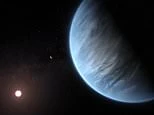The Hunt for Alien Life: Uncovering Inhabited Planets in Deep Space
Scientists have made significant strides in the search for extraterrestrial life, with the identification of a crucial clue that could lead to the discovery of inhabited planets in deep space. This new breakthrough, outlined by researchers from the University of Birmingham and the Massachusetts Institute of technology, offers an exciting prospect for uncovering the presence of life on distant worlds.
Clues from Carbon Dioxide Levels
One key insight that has emerged from the latest research is the correlation between low carbon dioxide levels on far-off planets and their potential for sustaining life. This link suggests that planets with depleted carbon dioxide levels might host oceans and possess a protective ozone layer – both essential conditions for supporting life.
According to the findings, the absence of high carbon dioxide levels could indicate that oceans and plants play a role in absorbing the compound, hinting at the possibility of these planets being habitable. The implications of this discovery are monumental, as it provides a new avenue for identifying and studying potentially inhabited planets.
Paving the Way for Future Discoveries
Julien de Wit, an assistant professor of planetary sciences at MIT, expressed the significance of this breakthrough, stating, “The Holy Grail in exoplanet science is to look for habitable worlds and the presence of life, but all the Features that have been talked about so far have been beyond the reach of the newest observatories.”
However, with this new clue, scientists are optimistic about the prospects of determining the presence of liquid water on distant planets within the next few years, leveraging the capabilities of advanced observatories such as nasa‘s James Webb Space Telescope.
Challenges in Exoplanet Exploration
Identifying inhabited planets in the vast expanse of space is no small feat. While current technologies have enabled the detection of over 5,200 exoplanets, the quest for earth-like, habitable worlds remains ongoing. Existing methods, including the search for light reflections on planets, have their limitations, particularly when it comes to investigating distant, unexplored planets.
Martin Turbet, a researcher involved in the study, highlighted the need for innovative approaches by stating, “An idea came to us by looking at what’s going on with the terrestrial planets in our own system.” This emphasis on learning from our own planetary neighbors underscores the iterative nature of scientific discovery and exploration.
Unraveling Planetary Secrets
The team of scientists sought inspiration from the similarities observed among terrestrial planets in our solar system, particularly the presence of rocky surfaces and temperate regions on Venus, earth, and Mars. By examining these parallels, the researchers identified a potential indicator for habitability – significantly lower carbon dioxide levels in a planet’s atmosphere, a feature distinct to earth.
To further validate their hypothesis, the team proposed a systematic approach that involves identifying groups of terrestrial planets orbiting in close proximity, akin to our Solar System, followed by confirming the presence of atmospheres and measuring the carbon dioxide levels within these planetary atmospheres. This comprehensive strategy presents a promising method for uncovering potential habitable worlds in deep space.
The Role of Ozone in Identifying Inhabited Planets
The presence of ozone emerged as a crucial factor in determining the likelihood of planetary habitability. By examining the interconnected processes on earth, where carbon dioxide absorption and subsequent oxygen emission contribute to the formation of ozone, researchers have established a potential method for detecting the presence of life on distant planets.
As Dr. Triaud noted, “If we see ozone, chances are pretty high that it’s connected to carbon dioxide being consumed by life.” This correlation underscores the potential for detecting not just signs of microbial life, but the presence of planetary-scale biomass that actively interacts with carbon, further enhancing the prospects of discovering inhabited worlds beyond our Solar System.
The Future of Exoplanet Exploration
The groundbreaking research conducted by scientists from the University of Birmingham and MIT represents a significant leap forward in the quest to identify and study habitable exoplanets. As advances in observational technologies continue to unfold, including the deployment of cutting-edge telescopes and space Missions, the potential for discovering alien life on distant worlds grows increasingly promising.
This newfound understanding of the clues associated with carbon dioxide levels, potential ozone presence, and the search for liquid water on exoplanets opens up a realm of possibilities for future exploration. By harnessing these insights, scientists and astronomers are edging closer to unlocking the ultimate mystery of alien life in the cosmos.
Source: dailymailuk








No Comments